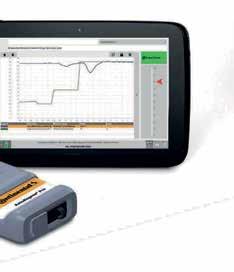
3 minute read
PRODUCT FEATURE
Addressing illumination issues could soon require network diagnostics and advanced computer programming.
Lighting in the ADAS age By Allan Janssen
It’s difficult to overstate the transformative impact of advanced driverassist systems (ADAS) technology on virtually every aspect of the modern automobile. And lighting – both interior and exterior – has certainly not been exempt from the revolution.
It started years ago with the introduction of light-emitting diodes (LEDs), but that was a baby step compared to what is happening now, as carmakers apply ADAS principles in an effort to raise lighting capabilities to a whole new level.
Exterior lighting trends reflect the general direction of all automotive technology: enhancing communication between road users and transportation infrastructure.
The key, of course, is that LEDs can be grouped together to form a matrix




or cluster. Controlled by a sophisticated computer program, they can create complex patterns and perform elaborate functions that are a playground for designers, and a benefit to drivers.
Think of all the lighting challenges that drivers have become used to: reduced projection when approaching an incline or decline, blinding glare when encountering an approaching vehicle, darkened peripheries when turning, confusing shadows on rough roadways, and complex light patterns in urban settings. These issues and many others like them can be resolved with the latest advances.
The newest innovations include dimming and adaptive front lighting (AFL). Dimming, used to prevent blinding oncoming vehicles, is accomplished with pulse-width modulation (PWM). AFL consists of additional lights used in pre-defined situations, such as turning tight corners and approaching altered driving conditions (hills, construction zones, crosswalks, oncoming traffic, and crossing pedestrians).
Digital lighting, centrally programmed and controlled by artificial intelligence, represents the future of automotive lighting, employing dense computer algorithms to control lenses, individual LEDs, and micromirrors in the creation of countless problem-solving illumination patterns.
Digitization works hand-in-glove with ADAS and autonomous driving technology… and it’s on a tremendous growth curve fueled by demand for energy efficiency and road safety. With new applications and functions accelerating, diagnosing lighting systems, replacing lenses, aiming and calibrating will soon require entirely new processes in the service bay.
Stepper motors – commonly used to adjust beam patterns – will become an entirely new diagnostic opportunity.
Understanding electronics will be a critical tool in any technician’s toolkit. Traditional lighting systems employed a body control module (BCM) in-built with a microcontroller (MCU) base, to manipulate LED drivers. Modern versions consist of the BCM and a separate electronic control unit (ECU), each of which contain MCUs. The ECU contains the LED drivers. The MCU in the BCM operates the drivers via the MCU in the ECU. A controller-area-network (CAN) bus provides a communications link between the BCM and ECU.
This kind of interconnectivity enables a new feature: built-in diagnostics and failure protections. The system can detect open or shorted LEDs, heat build-up, and over-voltages.
Diagnosing illumination issues will increasingly require a knowledge of camera technology, sensors,

engine control units (ECUs) and image processing software. Replacing a bulb will no longer be a quick and mindless procedure.
The digital lighting revolution will necessitate more complex control systems, new components, and additional subassemblies – all of them opportunities for diagnosis, replacement, and calibration.
ADAS technology and the steady movement toward fully autonomous driving vehicles has completely revolutionized the lighting industry. To stay in the game, aftermarket technicians will require a working knowledge of the latest developments.
Anything less will force them to cede even more diagnostic work to dealership service departments.












